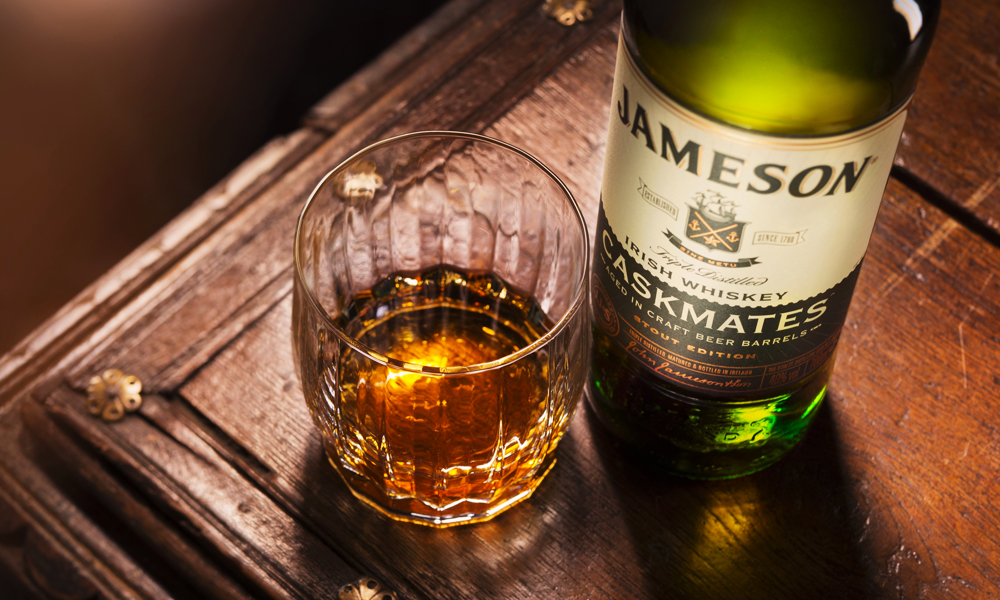Appreciating whiskey or bourbon, like appreciating anything in life, requires a certain level of attention. But what should you paying attention to? Brian Nation, Master Distiller at Jameson’s Midleton distillery, walked us through his sampling process so you could learn to drink whiskey like the man responsible for everything from your standard Jameson to Midleton Very Rare. Ready to start drinking whiskey like a master distiller? This is how to do it.
How to Properly Drink Whiskey
There’s no shame in eschewing the notebook and pencil and simply pouring yourself a bourbon on the rocks. Hell, whip up a delicious bourbon cocktail! But, if you’re curious about nailing flavor descriptors or actually picking out your favorite whiskey or bourbon, this guide is for you. As with all things, head into this exercise with some intentionality. When you’re ready to properly drink whiskey pick out a few bottles you’re curious about and host a little side-by-side tasting session. Your friends will appreciate the chance to drink some high-quality whiskey and you’ll have the perfect opportunity to put your palate to the test. So, without further ado, this is the proper way to drink whiskey.
STEP 1: Do Some Homework
Before you even pick up a bottle, you need to do a little homework. When was the last time you smelled an apple? Have you ever smelled an apple? When was the last time you ate a piece of caramel candy without being distracted by your Twitter feed? To begin to identify notes in whiskey, you have to become familiar with them in their original form. “It’s all about getting your descriptors right,” Nation said. “Knowing the universal descriptors is absolutely key in describing and appreciating whiskey.”

And while you should start paying attention to the aroma and taste of all the things you eat, there is a little shortcut to training that Nation recommends: “Look into whiskey tasting packs you can get with all these different flavors; then you can sit around and nose them on their own.” (Here’s one whiskey flavor kit we found.)
STEP 2: Pour and Smell
Nation always smells his whiskey neat (without water or ice) first. This allows him to add water later on and compare. How can you know which way you prefer a particular whiskey without testing it both ways?
“When I nose it, I like to associate the flavors I’m getting with my experiences and with things I’ve cooked,” Nation said. So when you put your nose in your glass, does it remind you of a freshly cut soccer field you used to play on? How about a peeled orange? Think back and nail those descriptors.
“I also think of the makeup of the whiskey: How old is it? What barrels were used? These are things that help identify certain elements.”
STEP 3: Taste It
Don’t go knocking it back like you were pregaming for a college rivalry. Follow Nation’s lead and take a sip and let it sit on your tongue for three seconds before you swallow. You want it to hit every part of your tongue. As you swallow, start appreciating the flavors in your mouth and those you just inhaled. Lots of dried fruit? Probably something involving a sherry cask. Packed with vanilla? That whiskey probably sat in some American oak that housed bourbon in a previous life. These are just a few of the things you can start associating with particular elements.
Swallowing isn’t the end of the tasting process. After you’ve let that warmth hit your stomach, pay close attention to the finish. “I’m always looking for a finish that lingers and brings me through the spectrum of the flavors,” Nation said. “It’s almost bringing you back through the process, through where it came from: wood to distillate to grain. That, to me, is a sign of a great whiskey.”
Often, the whiskey you drink won’t be a perfectly balanced masterpiece. In these situations, look at what flavors jut out. Do you get tons of toasted oak and bourbon from the casks? How about those spicy notes of cinnamon and pepper? Knowing the profile of a whiskey can help you decide whether it would be ideal for a certain cocktail where those elements would be welcome.
STEP 4: Repeat Again with Water
“When you add those three drops of water, you effectively open up the flavors and mute the alcohol,” Nation said. “Sometimes water sits well with some whiskies; sometimes they’re better off neat. You need to experiment and figure out which way you prefer for every whiskey you taste. Jameson, for example, is triple distilled and very smooth so you probably don’t need any water, but it’s all about finding out how you enjoy it.”

Water is often considered when you’re drinking something cask-strength. Many whiskey lovers believe that a little bit of water brings all those notes hidden by alcohol to the forefront. But, as Nation said, it’s all about finding out how you enjoy it best.
STEP 5: Evaluate It
Was the whiskey you just consumed great, terrible, or something else? Was it perfect for a Manhattan, or was it perfect neat? Here’s what Nation had to say about what he looks for in a great whiskey:
“For me, with a great whiskey, it’s not about one flavor; it’s about a balance of flavors with a certain level of complexity. You’re struggling to find one prevalent note or flavor. And each time you go back to it, you notice something different. To me, that’s a great whiskey. But at the end of the day, it’s all about what you enjoy.”
Want to read more about the best bourbon and whiskey? Click here for Cool Material’s Guide to Bourbon.




